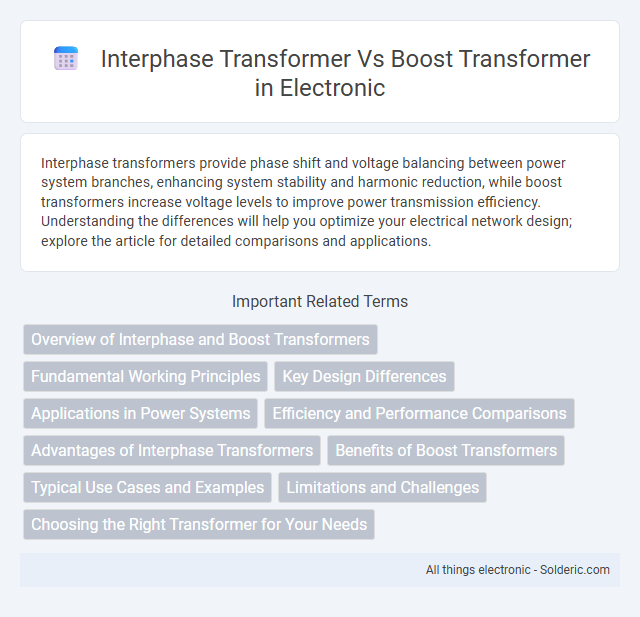Interphase transformers provide phase shift and voltage balancing between power system branches, enhancing system stability and harmonic reduction, while boost transformers increase voltage levels to improve power transmission efficiency. Understanding the differences will help you optimize your electrical network design; explore the article for detailed comparisons and applications.
Comparison Table
| Feature | Interphase Transformer | Boost Transformer |
|---|---|---|
| Primary Use | Voltage balancing between phases in three-phase systems | Increases output voltage above input voltage level |
| Function | Inter-phase voltage regulation and phase shifting | Voltage step-up through transformer winding configuration |
| Application | Power distribution for balanced load sharing | Power systems requiring voltage boost (e.g., renewable energy, industrial) |
| Design | Multiple windings to connect different phases directly | Winding turns ratio designed for voltage gain |
| Voltage Regulation | Maintains phase-to-phase voltage consistency | Raises voltage magnitude above supply level |
| Typical Rating | Medium to high power rating in three-phase distribution | Variable, depends on boost level and application |
Overview of Interphase and Boost Transformers
Interphase transformers are used to connect two separate transformer outputs, effectively combining or splitting phases to achieve desired voltage levels or configurations. Boost transformers increase the voltage from the primary to the secondary winding, commonly used in applications requiring voltage step-up, such as power distribution and industrial equipment. Understanding your system's voltage and phase requirements helps determine whether an interphase or boost transformer is the optimal choice.
Fundamental Working Principles
Interphase transformers operate by transferring energy between two circuit phases, enabling controlled voltage and phase angle adjustments through mutual inductance. Boost transformers increase voltage levels within a single phase by stepping up the input voltage using transformer windings designed for voltage amplification. Both types rely on electromagnetic induction principles but serve distinct functions in power regulation and phase management.
Key Design Differences
Interphase transformers feature isolated windings designed for phase shifting and harmonic reduction, while boost transformers primarily increase voltage levels with a simpler winding configuration. Interphase designs often incorporate multi-winding arrangements and additional insulation to manage interphase voltages, unlike boost transformers that emphasize efficient voltage step-up. Your choice depends on whether you need enhanced phase angle control and harmonic mitigation or straightforward voltage elevation.
Applications in Power Systems
Interphase transformers are primarily used in power systems for phase shifting and balancing load currents in multi-winding transformer arrangements, enhancing stability and reducing harmonics in complex power networks. Boost transformers serve to increase voltage levels efficiently in transmission lines, facilitating long-distance power transfer and voltage regulation. Both transformers optimize power flow, with interphase transformers improving system reliability and boost transformers enabling voltage step-up for efficient energy distribution.
Efficiency and Performance Comparisons
Interphase transformers deliver higher efficiency by minimizing voltage drop and power loss during parallel-phase power distribution, making them ideal for balancing loads in industrial systems. Boost transformers enhance voltage levels to meet specific application requirements but may experience slightly reduced efficiency due to increased energy conversion stages. Your choice depends on whether maximizing operational efficiency or achieving voltage elevation is the priority for your electrical design.
Advantages of Interphase Transformers
Interphase transformers provide improved voltage regulation and reduced harmonic distortion compared to boost transformers, enhancing power quality and system stability. They offer better load sharing in parallel transformer operations and lower losses due to their specialized design. Your power system benefits from increased efficiency and reliability when using interphase transformers in multiphase configurations.
Benefits of Boost Transformers
Boost transformers increase voltage levels to improve the efficiency of electrical distribution systems by minimizing line losses and stabilizing power supply. They enable better voltage regulation, which protects sensitive equipment and ensures consistent power quality for your operations. Compared to interphase transformers, boost transformers offer enhanced reliability and capacity for handling voltage increases in complex industrial applications.
Typical Use Cases and Examples
Interphase transformers are primarily used in power transmission systems to connect parallel circuits and balance loads between transmission lines, often applied in high-voltage network interconnections. Boost transformers serve crucial roles in electrical substations and industrial applications to increase voltage levels for efficient power delivery, commonly found in step-up transformer stations and large motor drives. Typical examples include interphase transformers in multi-terminal HVDC systems and boost transformers in renewable energy integration and industrial manufacturing plants.
Limitations and Challenges
Interphase transformers face limitations such as increased complexity and size, making them less suitable for compact power systems compared to boost transformers. Boost transformers often contend with challenges related to voltage regulation and thermal management due to higher operational stresses during voltage step-up processes. Both types require careful design considerations to address issues of insulation, efficiency, and reliability under varying load conditions.
Choosing the Right Transformer for Your Needs
Interphase transformers are ideal for balancing voltages between parallel systems and reducing harmonic distortion, making them suitable for complex industrial applications. Boost transformers increase voltage to compensate for system losses, enhancing power delivery efficiency in long-distance transmission. Your choice depends on whether you need voltage regulation and phase balancing (interphase) or voltage step-up for transmission efficiency (boost).
interphase transformer vs boost transformer Infographic

 solderic.com
solderic.com